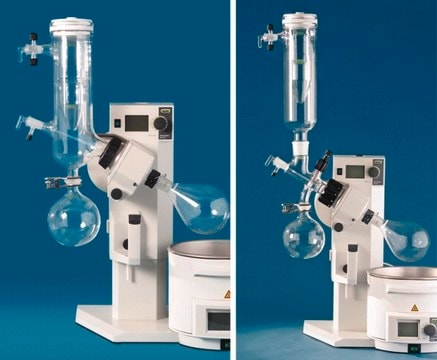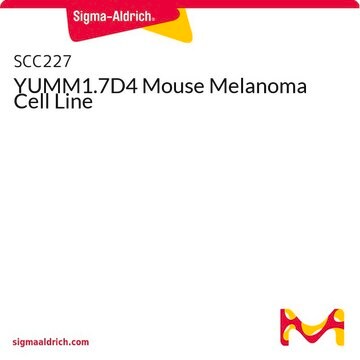SCC191
YUMM1.7 Mouse Melanoma Cell Line
Autenticatiper visualizzare i prezzi riservati alla tua organizzazione & contrattuali
About This Item
Codice UNSPSC:
41106514
eCl@ss:
32011203
NACRES:
NA.45
Prodotti consigliati
Descrizione
Cell line type: Cancer Cells
tecniche
cell culture | mammalian: suitable
Descrizione generale
Source:
The YUMM1.7 mouse melanoma cell line was derived from a 4-hydroxytamoxifen-induced melanoma tumor in a male C57/B1/6 mouse into which mutations from the Braf/Pten genetically-engineered mouse model had been introduced via backcrossing. The YUMM1.7 cell line harbors the Braf V600E mutation and is homozygous negative for wild-type Pten and Cdkn2 (1).
The YUMM1.7 mouse melanoma cell line was derived from a 4-hydroxytamoxifen-induced melanoma tumor in a male C57/B1/6 mouse into which mutations from the Braf/Pten genetically-engineered mouse model had been introduced via backcrossing. The YUMM1.7 cell line harbors the Braf V600E mutation and is homozygous negative for wild-type Pten and Cdkn2 (1).
The great promise of immune-based therapies in cancer and recent progress in successful application of these approaches has brought to the fore the necessity of immune-competent models to evaluate immune system responses to cancer cells. Immunocompetent genetically-engineered mouse models harboring discrete genetic drivers of melanoma are essential for studying potential immunotherapies but are limited by the need to maintain colonies of multiple genotypes necessary to generate mouse models with appropriate genetic backgrounds.
The YUMM1.7 mouse melanoma cell line was developed as an immunocompetent cell line that recapitulates genetic drivers found in a significant proportion of human melanomas (1). YUMM1.7 cells are syngeneic with the immunocompetent C57/B1/6 mouse background and retain genetic markers of the Braf/Pten mouse model, characterized by activation of Braf and inactivation of Pten and Cdkn2a, in which melanoma tumors develop with short latency (2). YUMM1.7 cells are highly tumorigenic in vivo (1). The YUMM1.7 mouse melanoma cell line represents a valuable tool for tumor immunology and cancer biology, especially tractable for the evaluation and generation of new immunotherapies.
References:
1. Meeth K et al. (2016) The YUMM lines: a series of congenic mouse melanoma cell lines with defined genetic alterations. Pigment Cell Melanoma Res 29(5): 590-597.
2. Dankort D et al. (2009) Braf(V600E) cooperates with Pten loss to induce metastatic melanoma. Nat Genet. 41(5): 544-552.
The YUMM1.7 mouse melanoma cell line was developed as an immunocompetent cell line that recapitulates genetic drivers found in a significant proportion of human melanomas (1). YUMM1.7 cells are syngeneic with the immunocompetent C57/B1/6 mouse background and retain genetic markers of the Braf/Pten mouse model, characterized by activation of Braf and inactivation of Pten and Cdkn2a, in which melanoma tumors develop with short latency (2). YUMM1.7 cells are highly tumorigenic in vivo (1). The YUMM1.7 mouse melanoma cell line represents a valuable tool for tumor immunology and cancer biology, especially tractable for the evaluation and generation of new immunotherapies.
References:
1. Meeth K et al. (2016) The YUMM lines: a series of congenic mouse melanoma cell lines with defined genetic alterations. Pigment Cell Melanoma Res 29(5): 590-597.
2. Dankort D et al. (2009) Braf(V600E) cooperates with Pten loss to induce metastatic melanoma. Nat Genet. 41(5): 544-552.
Applicazioni
This product is intended for sale and sold solely to academic institutions for internal academic research use per the terms of the “Academic Use Agreement” as detailed in the product documentation. For information regarding any other use, please contact licensing@emdmillipore.com.
Qualità
- Each vial contains >=1X106 viable cells.
- Cells are tested negative for infectious diseases by a Human Essential CLEAR panel by Charles River Animal Diagnostic Services.
- Cells are verified to be of human origin and negative for inter-species contamination from rat, mouse, chinese hamster, Golden Syrian hamster, and non-human primate (NHP) as assessed by a Contamination CLEAR panel by Charles River Animal Diagnostic Services.
- Cells are negative for mycoplasma contamination.
- Each lot of cells is genotyped by STR analysis to verify the unique identity of the cell line.
Stoccaggio e stabilità
Store in liquid nitrogen. The cells can be cultured for at least 10 passages after initial thawing without significantly affecting the cell marker expression and functionality.
Esclusione di responsabilità
This product contains genetically modified organisms (GMO). Within the EU GMOs are regulated by Directives 2001/18/EC and 2009/41/EC of the European Parliament and of the Council and their national implementation in the member States respectively. This legislation obliges {HCompany} to request certain information about you and the establishment where the GMOs are being handled. Click here for Enduser Declaration (EUD) Form.Unless otherwise stated in our catalog or other company documentation accompanying the product(s), our products are intended for research use only and are not to be used for any other purpose, which includes but is not limited to, unauthorized commercial uses, in vitro diagnostic uses, ex vivo or in vivo therapeutic uses or any type of consumption or application to humans or animals.
Codice della classe di stoccaggio
12 - Non Combustible Liquids
Classe di pericolosità dell'acqua (WGK)
WGK 1
Punto d’infiammabilità (°F)
Not applicable
Punto d’infiammabilità (°C)
Not applicable
Certificati d'analisi (COA)
Cerca il Certificati d'analisi (COA) digitando il numero di lotto/batch corrispondente. I numeri di lotto o di batch sono stampati sull'etichetta dei prodotti dopo la parola ‘Lotto’ o ‘Batch’.
Possiedi già questo prodotto?
I documenti relativi ai prodotti acquistati recentemente sono disponibili nell’Archivio dei documenti.
Il team dei nostri ricercatori vanta grande esperienza in tutte le aree della ricerca quali Life Science, scienza dei materiali, sintesi chimica, cromatografia, discipline analitiche, ecc..
Contatta l'Assistenza Tecnica.







